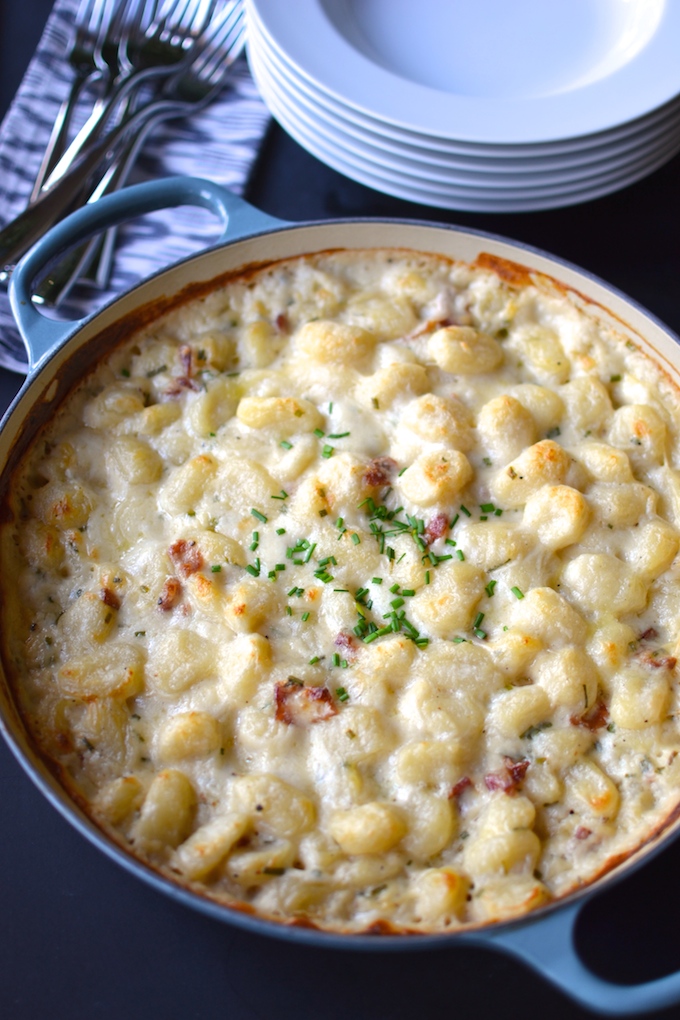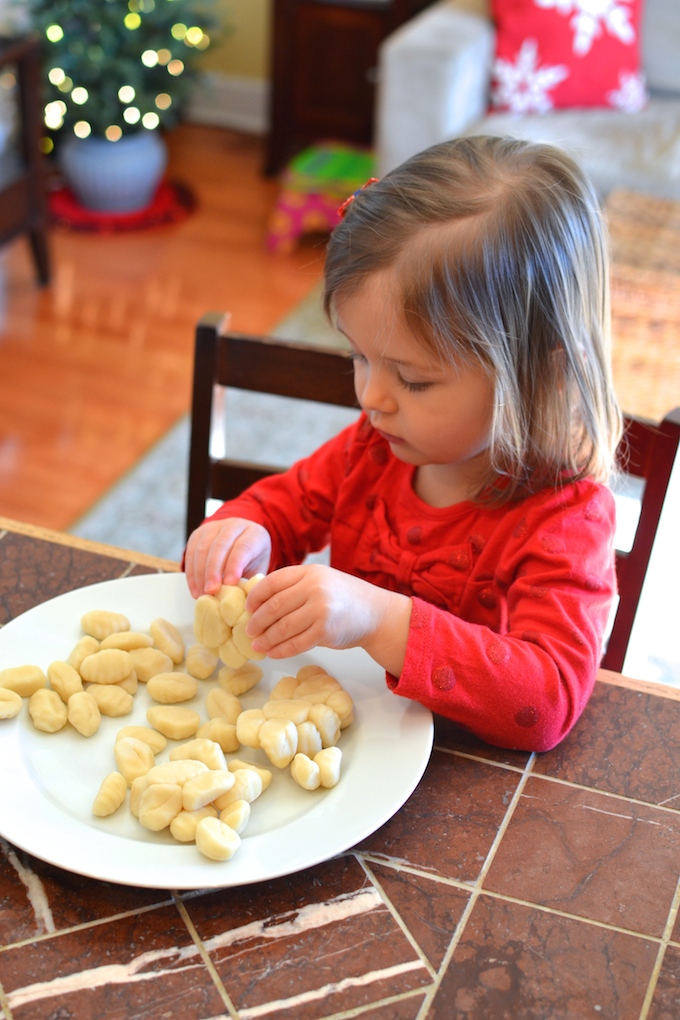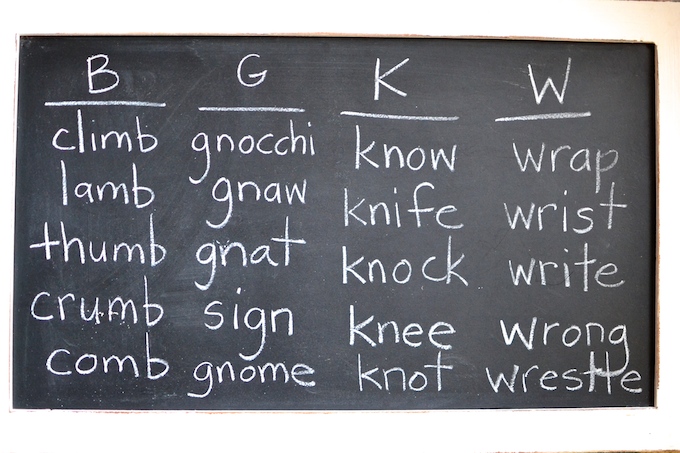
Cheese, cheese and more cheese! I just love it. I think I was somehow supposed to be born in Wisconsin, instead of California. I guess it’s fate that I married the boy from Wisconsin, huh?
This Three Cheese Gnocchi Gratin is AMAZING. And the boy from Wisconsin (who typically nods and says “…it’s good…” when I ask how a new recipe tastes) thinks this is AMAZING too. That’s saying something.

Soft, pillowy gnocchi covered in a nutty, two-cheese sauce (with bacon!), topped with a third cheese and then baked until bubbly and golden brown. It’s kind of like a grown-up macaroni and cheese…AhhhMAZING.

This dish is easy to make, yet elegant enough for a holiday dinner. I’m thinking Christmas Eve, alongside a roast or steak of some sort.
Wait, roasted meat and three-cheese gnocchi? Gosh, who am I? Where are my California roots?
Okay, we’ll have a kale salad to start…

…and then, this Three Cheese Gnocchi Gratin.
Em just adores gnocchi, especially the mini-gnocchi that I often find right next to the regular-sized gnocchi in the grocery store. If you think the cheeses in this dish may be too strong for your little one, try setting aside some plain gnocchi for them to eat (topped with a little butter, parmesan and peas), or use different cheeses, such as monterey jack or fontina, which are more mild in flavor.
Little Hands Can…
- Break apart the uncooked gnocchi dumplings (they usually clump together in the package and cook more evenly if you break them into individual dumplings first)
- Crumble the cooked and cooled bacon
- Older kids can help grate the cheeses
- Measure the ingredients
- Sprinkle cheese on top of the gnocchi gratin

- 4 slices of bacon
- 2 packages gnocchi
- 2 cups milk
- ½ cup chicken broth
- 3 tablespoons butter
- 3 tablespoons flour
- ¼ teaspoon each salt and pepper
- ½ cup shredded gruyere cheese
- ½ cup shredded provolone cheese (mild or sharp)
- ¼ cup chopped chives (or green onions)
- ¼ cup parmesan cheese
- Preheat the oven to 400 degrees.
- In a large pan, cook the bacon over medium heat until brown and crispy. Drain on a paper-towel lined plate. When cool, crumble the bacon into small pieces
- Meanwhile, heat a large pot of water to boiling and cook the gnocchi according to package directions. The dumplings are usually done when they float the surface of the water. Drain and set aside.
- Warm the milk and chicken broth in a small saucepan on low heat, or in a microwavable cup/bowl for 1 minute on high.
- In a large saute pan, melt the butter over medium heat. When the butter is melted, add the flour, salt and pepper and whisk for about 1 minute, until a paste forms and the flour has a chance to cook a bit.
- Slowly add in the warm milk/broth mixture and whisk until the sauce comes together. Cook for 3-5 minutes until the sauce thickens.
- Add the gruyere and provolone cheeses and stir until the cheese melts.
- Turn off the heat and stir in the cooked, crumbled bacon and chives.
- Add the cooked gnocchi to the pan and toss well with the sauce.
- Spoon the gnocchi into a 9x12 inch baking dish, or you could keep the gnocchi in the sauté pan you used if the pan is oven-safe.
- Top the gnocchi with the parmesan cheese.
- Bake at 400 for 20 minutes,or until lightly golden brown.
- Let the gnocchi cool for 5 minutes before serving.
Recipe adapted from Cooking Light
On the Side
Gnocchi is pronounced /no-kee/ or /nyo-kee/… so, where’s the /g/ sound?! With this recipe, we’re exploring silent letters, beginning with the missing /g/ sound in the word “gnocchi”!
Silent letters are letters that are used to spell a word, but are not pronounced, or spoken. There are a few reasons why some words have silent letters. Sometimes, silent letters are added to words to help us pronounce other sounds in the word correctly. For example, the “e” at the end of words like “cute” and “ripe” is silent. However because the “e” is there, we know the word is not pronounced “cut” or “rip”. The silent “e” has a purpose, which is to make the other vowel in the word shout out it’s own name (the long vowel sound).
Some other words have silent letters that are historically significant, in that they reflect the origin of the word (that is, where the word first came from) and were never changed when spelled in the English language.
Here are some kid-friendly examples of words that have a silent letter…

Around the second grade level, students are ready to learn about silent letters (although there’s no reason why you can’t start talking about it sooner!). Show your child some of these words and talk to them about why some words have silent letters. Can you think of other words that have a silent letter? If they get stuck, give them a clue! Then write it down, so they can see how the word is spelled and which letter is silent.
I also recently learned about a great children’s book called Silent Letters Loud and Clear, by Robin Pulver, illustrated by Lynn Rowe Reed, in which one class of students thinks spelling is too hard with silent letters. When the letters learn that they’re not wanted, they strike(!) and the class learns about the importance of silent letters for spelling. The author also has a teaching guide for this book (and many of her other great books) on her website. This book is on my hold list at our local library.
Are there other food-related words you can think of that have a silent letter? (Hint: all words with a silent “magic-e” at the end!…bake, cake, rice, cheese, chive, grape, etc.)
Disclaimer: As with all of our recipes, my suggestions for how kids can help with a particular recipe are based on what has worked in our kitchen. Your child may be able to help more or less based on their age and/or ability.
Leave a Reply